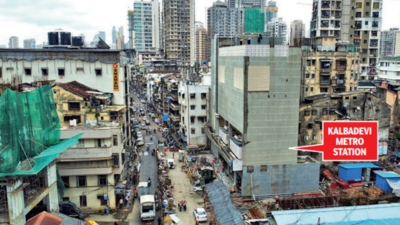ARTICLE AD BOX

The Kalbadevi and Girgaon metro stations, once at risk of being excluded from the initial launch due to civil and systems-related delays, are now set to open along with the final 9.5 km stretch of Metro Line 3 between Worli and Cuffe Parade.
Located in two of south Mumbai’s most congested and structurally sensitive areas, these underground stations faced early setbacks but are now on track for full commissioning, according to the Mumbai Metro Rail Corporation Ltd (MMRCL), the project’s implementing authority.Construction in these areas was particularly challenging. Narrow road widths — ranging from just 9 to 13 metres — left little room for excavation.
“We had to maintain at least 6 metres for daily traffic while using the rest for construction,” said Subodh Gupta, director (projects), MMRCL. Further delays stemmed from complex land acquisition issues, legal disputes, and the presence of over 300 structurally vulnerable buildings — many of them heritage properties — along the alignment.To mitigate risks, MMRCL adopted the New Austrian Tunneling Method (NATM), which enabled deep underground construction with minimal surface disruption.
Controlled blasting was carried out under strict vibration limits (2.54 PVB, or peak velocity in decibels), and extensive monitoring systems were installed on surrounding structures. Reinforcements were added as needed, and notably, no residents were displaced during the construction process.
Beyond civil engineering hurdles, skipping these two stations posed serious operational challenges. Metro 3 is designed as a high-frequency, automated corridor using Communication-Based Train Control (CBTC), where each station plays a crucial role in maintaining system logic and train communication.
Skipping stations mid-route would have required complex reprogramming and operational adjustments.Logistics were another concern. With narrow lanes and densely packed buildings, transporting equipment, concrete, and debris demanded precision and careful planning. Night work was restricted due to proximity to residential areas, and certain parts of the alignment had to be modified to accommodate religious structures — done in consultation with local communities.The project has also had a significant human impact. Construction of the Kalbadevi and Girgaon stations affected 19 buildings and 634 families. MMRCL carried out in-situ rehabilitation for these project-affected families (PAFs). The acquired land has been used for station infrastructure, including ancillary structures, ventilation shafts, and access points.As part of the rehabilitation package, all displaced residents received upgraded housing.
Chief minister Devendra Fadnavis had earlier assured that affected families would receive homes at least twice the size of their current dwellings. For instance, those currently in 100-150 sq ft units will receive 405 sq ft homes; 250 sq ft occupants will get 500 sq ft, and those in 300 sq ft units will be allotted 600 sq ft. Standard rehabilitation rules will apply to those with larger properties, with free allotments up to 700 sq ft and construction cost applicable beyond that.With commissioning now in sight, the Kalbadevi and Girgaon stations stand as critical elements of the Metro 3 project. “We’ve achieved this breakthrough through detailed planning and engineering innovation,” said an official. “Not to forget sustained community engagement.”



.png)
.png)
.png)
















 1 hour ago
5
1 hour ago
5









 English (US) ·
English (US) ·